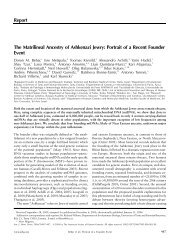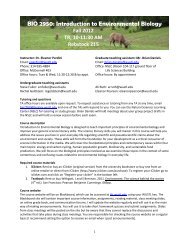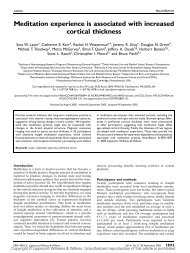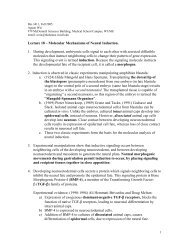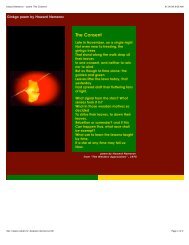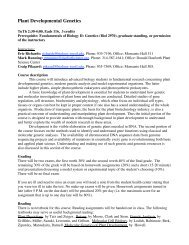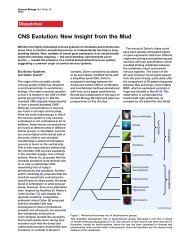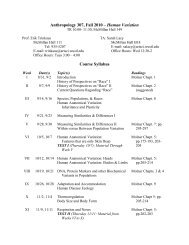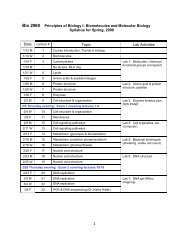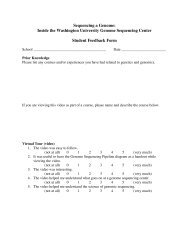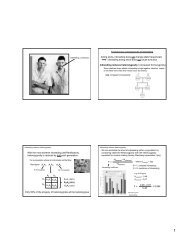P ERSPECTIVES ON DISEASEU. <strong>Bellugi</strong> <strong>et</strong> <strong>al</strong>. – Linking cognition <strong>and</strong> the brainAcknowledgmentsThe authors’research wassupported in part bygrants to U.B. fromthe Nation<strong>al</strong>Institutes of He<strong>al</strong>th(PO1 HD33113,P50 NS22343, P50DC01289), theJames McDonnellFoundation, <strong>and</strong> theOak TreePhilanthropicFoundation. Theauthors thank theNation<strong>al</strong> <strong>and</strong>Region<strong>al</strong> WilliamsSyndromeAssociations, <strong>and</strong>the Nation<strong>al</strong> <strong>and</strong>Region<strong>al</strong> DownSyndromeAssociations. Theauthors are gratefulto the subjects <strong>and</strong>their families fortheir participationin these studies.WMS (Refs 77,79). However, <strong>al</strong>though absence of onecopy of LIMK1 had been implicated in the spati<strong>al</strong> deficitcharacteristic of WMS (Ref. 60), recent work unexpectedlyreve<strong>al</strong>ed that the del<strong>et</strong>ion of this gene <strong>and</strong> othersin the region was compatible with norm<strong>al</strong> function 77 .Further, preliminary an<strong>al</strong>yses of individu<strong>al</strong>s with thefaci<strong>al</strong>, cardiac <strong>and</strong> ment<strong>al</strong> r<strong>et</strong>ardation features of WMSbut with a sm<strong>al</strong>ler del<strong>et</strong>ion, indicate that the region ofthe FZD3 gene might not be essenti<strong>al</strong> for the developmentof these typic<strong>al</strong> diagnostic features 69 . In summary,using this approach, it is now becoming possible to linkaspects of the phenotypic profile (specific cognitivefunctions, faci<strong>al</strong> features, sociability <strong>and</strong> spati<strong>al</strong> deficits)to their gen<strong>et</strong>ic origins (Fig. 8B).Important issues revolve, in part, around the definitionof the remaining genes in the common del<strong>et</strong>edregion 69,76,77 . Furthermore, it is essenti<strong>al</strong> to dissect WMScognitive features further <strong>and</strong> to d<strong>et</strong>ermine the contributionsof single genes <strong>and</strong> their interactions with othersin the del<strong>et</strong>ed regions, to each of these features<strong>and</strong> to the other characteristic embryologic<strong>al</strong>, neuroanatomic<strong>al</strong>,physiologic<strong>al</strong> <strong>and</strong> function<strong>al</strong> l<strong>and</strong>marks ofWMS, as well as to the gen<strong>et</strong>ic origins of variability inthese phenotypes. Future studies will focus on thosegenes mapping to regions that, when del<strong>et</strong>ed, are notcompatible with norm<strong>al</strong> phenotypes, but rather generatesubs<strong>et</strong>s of the features of particular interest inWMS. Anim<strong>al</strong> models of the WMS del<strong>et</strong>ion will be usefulbut it is expected that underst<strong>and</strong>ing many aspectsof human cognition <strong>and</strong> its gen<strong>et</strong>ic underpinnings willultimately rest on studying humans. Such human studiesmight depend on the need to define further rareindividu<strong>al</strong>s with WMS <strong>and</strong> sm<strong>al</strong>l del<strong>et</strong>ions, <strong>and</strong> to combin<strong>et</strong>heir molecular structures with a sophisticatedunderst<strong>and</strong>ing of their neurocognitive <strong>and</strong> behavior<strong>al</strong>phenotypes. Although many genes probably contribut<strong>et</strong>o the ment<strong>al</strong> r<strong>et</strong>ardation, it will without doubt be ofinterest to d<strong>et</strong>ermine wh<strong>et</strong>her specific genes could beresponsible for hypersociability, visu<strong>al</strong>–spati<strong>al</strong> deficitsor to the characteristic ERPs that might be markers forWMS. Hopefully, these new studies will provide th<strong>et</strong>ools for investigating human evolution <strong>and</strong>, ultimately,the clues to the pathways that lead to the cognitivefeatures of WMS <strong>and</strong> underlie norm<strong>al</strong> humancognition 80–82 .Concluding remarksOne of the greatest ch<strong>al</strong>lenges faced in underst<strong>and</strong>ingthe brain <strong>and</strong> cognition is the need to link investigationsacross disciplines within the neurosciences. Untilnow, this go<strong>al</strong> has remained unachievable. The studiesreviewed here using a specific neurogen<strong>et</strong>ic disorder,which presents unusu<strong>al</strong> dissociations in highercortic<strong>al</strong> functioning, might provide opportunities toexplore some of the centr<strong>al</strong> issues of cognitive neuroscienc<strong>et</strong>hat tie cognitive functions to brain organization<strong>and</strong>, ultimately, to the human genome.Selected references1 <strong>Bellugi</strong>, U. <strong>et</strong> <strong>al</strong>. in Neurodevelopment<strong>al</strong> Disorders: Contributionsto a New Framework from the Cognitive Neurosciences (Tager-Flusberg, H., ed.), MIT Press (in press)2 <strong>Bellugi</strong>, U., Klima, E.S. <strong>and</strong> Wang, P.P. (1996) in The Life-SpanDevelopment of Individu<strong>al</strong>s: Behavior<strong>al</strong>, Neurobiologic<strong>al</strong>, <strong>and</strong>Psychosoci<strong>al</strong> Perspectives. The Nobel Symposium (Magnussen, D.,ed.), pp. 223–243, Cambridge University Press3 <strong>Bellugi</strong>, U., Wang, P.P. <strong>and</strong> Jernigan, T.L. (1994) in Atypic<strong>al</strong>Cognitive Deficits in Development<strong>al</strong> Disorders: Implications for <strong>Brain</strong>Function (Broman, S. <strong>and</strong> Grafman, J., eds), pp. 23–56, LawrenceErlbaum4 <strong>Bellugi</strong>, U. <strong>et</strong> <strong>al</strong>. (1990) Am. J. Med. Gen<strong>et</strong>. 6, 115–1255 <strong>Bellugi</strong>, U. <strong>et</strong> <strong>al</strong>. (1992) in Development<strong>al</strong> Behavior<strong>al</strong> Neuroscience(Gunnar, M. <strong>and</strong> Nelson, C., eds), pp. 201–232, LawrenceErlbaum Associates6 Mervis, C. <strong>et</strong> <strong>al</strong>. in Neurodevelopment<strong>al</strong> Disorders: Contributions toa New Framework from the Cognitive Neurosciences (Tager-Flusberg, H., ed.), MIT Press (in press)7 Vicari, S. <strong>et</strong> <strong>al</strong>. (1996) Cortex 32, 503–5148 Lenhoff, H.M. <strong>et</strong> <strong>al</strong>. (1997) Sci. Am. 277, 68–739 <strong>Bellugi</strong>, U. (1998) Soc. Cog. Neurosci. Amstar. 5, 9–1110 Karmiloff-Smith, A. (1998) Trends Cognit. Sci. 2, 289–29811 Lowery, M.C. <strong>et</strong> <strong>al</strong>. (1995) Am. J. Hum. Gen<strong>et</strong>. 57, 49–5312 Keating, M.T. (1995) Circulation 92, 142–14713 Pober, P.R. <strong>and</strong> Dykens, E.M. (1996) Child Adolesc. Psychiatr.Clin. North Am. 5, 929–94314 Udwin, O. (1990) Dev. Med. Child Neurol. 32, 129–14115 Volterra, V. <strong>et</strong> <strong>al</strong>. (1996) Cortex 32, 663–67716 Singer, N.G. <strong>et</strong> <strong>al</strong>. (1997) Dev. Neuropsychol. 13, 345–37017 Rossen, M.L. <strong>et</strong> <strong>al</strong>. (1996) in Language, Learning, <strong>and</strong> BehaviorDisorders: Development<strong>al</strong>, Biologic<strong>al</strong>, <strong>and</strong> Clinic<strong>al</strong> Perspectives(Beitchman, J.H. <strong>et</strong> <strong>al</strong>., eds), pp. 367–392, Cambridge UniversityPress18 Karmiloff-Smith, A. <strong>et</strong> <strong>al</strong>. (1997) Child Dev. 68, 246–26219 Grant, J. <strong>et</strong> <strong>al</strong>. (1996) Cahiers de Psychologie Cognitive 15, 615–62820 Jarrold, C., Baddley, A.D. <strong>and</strong> Hewes, A.K. (1998) J. ChildPsychol. Psychiatry 39, 511–52321 <strong>Bellugi</strong>, U. <strong>et</strong> <strong>al</strong>. (1998) Excessive Use of Linguistic<strong>al</strong>ly EncodedAffect: Stories from Young Children with Williams Syndrome(Technic<strong>al</strong> Report CND-9801), University of C<strong>al</strong>ifornia22 Stevens, T. <strong>and</strong> Karmiloff-Smith, A. (1997) J. Child Lang. 24,737–76523 Lichtenberger, L. <strong>and</strong> <strong>Bellugi</strong>, U. (1998) Soc. Cognit. Neurosci.Abstr. 80, 6824 Clahsen, H. <strong>and</strong> Almazan, M. (1998) Cognition 68, 167–19825 Pinker, S. (1994) The Language Instinct, Penguin26 Reilly, J.S., Klima, E.S. <strong>and</strong> <strong>Bellugi</strong>, U. (1990) Dev.Psychopathol. 2, 367–39127 Einfeld, S.L., Tonge, B.J. <strong>and</strong> Florio, T. (1997) Am J. Psychiatry102, 45–5328 Davies, M.O., Udwin, O. <strong>and</strong> Howlin, P. (1998) Br. J. Psychiatry172, 273–27629 Reilly, J.S., Harrison, D. <strong>and</strong> Klima, E.S. (1995) Gen<strong>et</strong>. Coun. 6,158–15930 Harrison, D., Reilly, J. <strong>and</strong> Klima, E.S. (1995) Gen<strong>et</strong>. Coun. 6,181–18331 Courchesne, E., <strong>Bellugi</strong>, U. <strong>and</strong> Singer, N. (1995) Gen<strong>et</strong>. Coun.6, 144–14532 Karmiloff-Smith, A. <strong>et</strong> <strong>al</strong>. (1995) J. Cogn. Neurosci. 7, 196–20833 Reilly, J., Bates, E. <strong>and</strong> Marchman, V. (1998) <strong>Brain</strong> Lang. 61,335–37534 Jones, W. <strong>et</strong> <strong>al</strong>. (1995) Soc. Neurosci. Abstr. 21, 192635 Jones, W. <strong>et</strong> <strong>al</strong>. (1998) Dissociations in Cognitive Development:Differenti<strong>al</strong> Effects From Two Gen<strong>et</strong>ic<strong>al</strong>ly Based Syndromes(Technic<strong>al</strong> Report CND-9805), University of C<strong>al</strong>ifornia36 Ber<strong>et</strong>, N. <strong>et</strong> <strong>al</strong>. (1997) Soc. Int. Behav. Neurosci. Abstr. 6, 5837 Bihrle, A.M. <strong>et</strong> <strong>al</strong>. (1989) <strong>Brain</strong> Cognit. 11, 37–4938 <strong>Bellugi</strong>, U. <strong>and</strong> Wang, P.P. (1998) in Encyclopedia ofNeuroscience (CD-Rom Version) (Edelman, G. <strong>and</strong> Smith, B.H.,eds), Elsevier Science39 Wang, P.P. <strong>et</strong> <strong>al</strong>. (1995) <strong>Brain</strong> Cognit. 29, 54–6540 Wang, P.P. <strong>and</strong> <strong>Bellugi</strong>, U. (1994) J. Clin. Exp. Neuropsy. 16,317–32241 Rossen, M.L. <strong>et</strong> <strong>al</strong>. (1995) Soc. Neurosci. Abstr. 21, 192642 Rossen, M.L. <strong>et</strong> <strong>al</strong>. (1995) Gen<strong>et</strong>. Coun. 6, 138–14043 Mills, D.L. (1998) Soc. Cognit. Neurosci. Abstr. 5, 1044 Wang, P.P. <strong>et</strong> <strong>al</strong>. (1992) Neurology 42, <strong>1999</strong>–200245 Mills, D.L. <strong>et</strong> <strong>al</strong>. (1997) Soc. Int. Behav. Neurosci. Abstr. 6, 5946 Neville, H., Mills, D.L. <strong>and</strong> <strong>Bellugi</strong>, U. (1994) in Atypic<strong>al</strong>Cognitive Deficits in Development<strong>al</strong> Disorders: Implications for <strong>Brain</strong>Function (Broman, S. <strong>and</strong> Grafman, J., eds), pp. 67–83, LawrenceErlbaum47 Neville, H., Mills, D.L. <strong>and</strong> <strong>Bellugi</strong>, U. (1995) Gen<strong>et</strong>. Coun. 6,141–14248 Hickok, G. <strong>et</strong> <strong>al</strong>. (1995) Soc. Cognit. Neurosci. Abstr. 2, 6649 Jernigan, T.L. <strong>and</strong> <strong>Bellugi</strong>, U. (1994) in Atypic<strong>al</strong> CognitiveDeficits in Development<strong>al</strong> Disorders: Implications for <strong>Brain</strong> Function(Broman, S. <strong>and</strong> Grafman, J., eds), pp. 57–66, Lawrence Erlbaum50 Jernigan, T.L. <strong>et</strong> <strong>al</strong>. (1993) Arch. Neurol. 50, 186–19151 Jernigan, T. <strong>and</strong> <strong>Bellugi</strong>, U. (1990) Arch. Neurol. 47, 529–53352 <strong>Bellugi</strong>, U. <strong>and</strong> Lai, Z. (1998) Am. Soc. J. Exp. Bio. Abstr. 12,A35553 Levitin, D.J. <strong>and</strong> <strong>Bellugi</strong>, U. (1998) Music Percept. 15, 357–38954 Atkinson, J. <strong>et</strong> <strong>al</strong>. (1997) NeuroReport 8, 1919–192255 G<strong>al</strong>aburda, A.M. <strong>et</strong> <strong>al</strong>. (1994) NeuroReport 5, 758–78756 G<strong>al</strong>aburda, A.M. (1998) Soc. Cognit. Neurosci. Abstr. 5, 10–1157 G<strong>al</strong>aburda, A.M. <strong>et</strong> <strong>al</strong>. (1995) Gen<strong>et</strong>. Coun. 6, 142–14458 Ewart, A.K. <strong>et</strong> <strong>al</strong>. (1993) Nat. Gen<strong>et</strong>. 5, 11–16206 TINS Vol. 22, No. 5, <strong>1999</strong>
U. <strong>Bellugi</strong> <strong>et</strong> <strong>al</strong>. – Linking cognition <strong>and</strong> the brain P ERSPECTIVES ON DISEASE59 Wang, Y.K. <strong>et</strong> <strong>al</strong>. (1997) Hum. Mol. Gen<strong>et</strong>. 6, 465–47260 Frangiskakis, J.M. <strong>et</strong> <strong>al</strong>. (1996) Cell 86, 59–6961 Osborne, L.R. <strong>et</strong> <strong>al</strong>. (1997) Am. J. Hum. Gen<strong>et</strong>. 61, 449–45262 Peoples, R. <strong>et</strong> <strong>al</strong>. (1996) Am. J. Hum. Gen<strong>et</strong>. 58, 1370–137363 Hoogenradd, C.C. <strong>et</strong> <strong>al</strong>. (1998) Genomics 53, 348–35864 Meng, X. <strong>et</strong> <strong>al</strong>. (1998) Genomics 52, 130–13765 Lu, X. <strong>et</strong> <strong>al</strong>. (1998) Genomics 54, 241–24966 Meng, X <strong>et</strong> <strong>al</strong>. (1998) Genomics 52, 130–13767 Jurado, L.A.P. <strong>et</strong> <strong>al</strong>. (1998) Hum. Mol. Gen<strong>et</strong>. 7, 325–33468 Wu, Y.Q. <strong>et</strong> <strong>al</strong>. (1998) Am. J. Med. Gen<strong>et</strong>. 78, 82–8969 Botta, A. <strong>et</strong> <strong>al</strong>. (1998) Am. Soc. Hum. Gen<strong>et</strong>. Prog. 63, A9870 Korenberg, J.R. <strong>et</strong> <strong>al</strong>. (1998) Soc. Cognit. Neurosci. Abstr. 5, 1171 Robinson, W.P. <strong>et</strong> <strong>al</strong>. (1996) Genomics 34, 17–2372 Osborne, L.R. <strong>et</strong> <strong>al</strong>. (1997) Genomics 45, 402–40673 Korenberg, J.R. <strong>et</strong> <strong>al</strong>. (1997) Am. J. Hum. Gen<strong>et</strong>. 61, 10374 Jurado, L.A.P. <strong>et</strong> <strong>al</strong>. (1996) Am. J. Hum. Gen<strong>et</strong>. 59, 781–79275 Nakayama, T. <strong>et</strong> <strong>al</strong>. (1998) Cytogen<strong>et</strong>. Cell Gen<strong>et</strong>. 82, 49–5176 Hirota, H. <strong>et</strong> <strong>al</strong>. (1998) Am. Soc. Hum. Gen<strong>et</strong>. Prog. 63, A13877 Tassabehji, M. <strong>et</strong> <strong>al</strong>. (<strong>1999</strong>) Am. J. Hum. Gen<strong>et</strong>. 64, 118–12578 Olson, T.M. <strong>et</strong> <strong>al</strong>. (1995) Hum Mol. Gen<strong>et</strong>. 4, 1677–167979 Li, D.Y. (1997) Hum. Mol. Gen<strong>et</strong>. 7, 1021–102880 Korenberg, J.R. <strong>et</strong> <strong>al</strong>. (1996) Am. J. Hum. Gen<strong>et</strong>. 59, A38681 Korenberg, J.R. <strong>et</strong> <strong>al</strong>. (1998) Soc.Cognit. Neurosci. Abstr. 5, 1182 <strong>Bellugi</strong>, U., Lai, Z.C. <strong>and</strong> Korenberg, J. in Frontiere della Biologia:The <strong>Brain</strong> of Homo Sapiens (Vol. 3) (Bizzi, E., C<strong>al</strong>issano, P. <strong>and</strong>Volterra V., eds), Istituto della Enciclopedia It<strong>al</strong>iana (in press)What is the amygd<strong>al</strong>a?A comparative approachL ETTERS TO THE EDITORation he proposed but the use of a comparativeperspective, which is essenti<strong>al</strong> toelaborate solid hypotheses concerning theanatomic<strong>al</strong> <strong>and</strong> function<strong>al</strong> organization ofthe brain.In their exciting <strong>and</strong> provocative article 1 ,Swanson <strong>and</strong> P<strong>et</strong>rovich consider the term‘amygd<strong>al</strong>a’ to be an arbitrary namedescribing a series of structures that areh<strong>et</strong>erogeneous from both anatomic<strong>al</strong> <strong>and</strong>function<strong>al</strong> viewpoints. Function<strong>al</strong>ly, theysee the amygd<strong>al</strong>a as being made up ofnuclei that belong to the autonomicnervous system (centr<strong>al</strong> nucleus), thevomeronas<strong>al</strong> system (medi<strong>al</strong>, posteromedi<strong>al</strong>cortic<strong>al</strong> <strong>and</strong> posterior nuclei), theolfactory system (the cortic<strong>al</strong> olfactorecipientnuclei, the basomedi<strong>al</strong> nucleus<strong>and</strong> the posterior part of the basolater<strong>al</strong>nucleus) <strong>and</strong> the frontotempor<strong>al</strong> cortic<strong>al</strong>system (later<strong>al</strong> nucleus <strong>and</strong> anterior basolater<strong>al</strong>nucleus). Anatomic<strong>al</strong>ly, they considerthe amygd<strong>al</strong>a to be composed oftradition<strong>al</strong> cortic<strong>al</strong> (cortic<strong>al</strong> nuclei <strong>and</strong>areas receiving direct olfactory input),claustr<strong>al</strong> (basolater<strong>al</strong> amygd<strong>al</strong>a) <strong>and</strong> striat<strong>al</strong>elements (centr<strong>al</strong> <strong>and</strong> medi<strong>al</strong> nuclei).In the past, a combination of differentm<strong>et</strong>hods has demonstrated the role of thebasolater<strong>al</strong> <strong>and</strong> centr<strong>al</strong> amygd<strong>al</strong>a in fearconditioning <strong>and</strong> emotion<strong>al</strong> learning 2–4 .Therefore, the basolater<strong>al</strong> amygd<strong>al</strong>a(frontotempor<strong>al</strong>) <strong>and</strong> the centr<strong>al</strong> amygd<strong>al</strong>a(autonomic) appear to constitute a singlefunction<strong>al</strong> system that, according toanatomic<strong>al</strong> data from reptile studies 5–7 ,appears to have been well conservedduring vertebrate evolution. Although theremaining amygd<strong>al</strong>oid nuclei certainlybelong to the main <strong>and</strong> accessory olfactorysystems (in view of the large number ofafferents from the olfactory bulbs), evenSwanson <strong>and</strong> P<strong>et</strong>rovich recognize that theyhave a s<strong>et</strong> of intricate interconnectionswith the centr<strong>al</strong> <strong>and</strong> basolater<strong>al</strong> amygd<strong>al</strong>a.The activity in the chemosensory amygd<strong>al</strong>amust, therefore, have a strong influence onthe basolater<strong>al</strong> <strong>and</strong> centr<strong>al</strong> amygd<strong>al</strong>a, whichsuggests a function<strong>al</strong> interdependence of <strong>al</strong>lthe amygd<strong>al</strong>oid nuclei.Addition<strong>al</strong>ly, as is emphasized by theauthors 1 , their structur<strong>al</strong> classification ofthe amygd<strong>al</strong>a coincides essenti<strong>al</strong>ly withthat proposed by Johnston in 1923(Ref. 8). Using a comparative perspective,Johnston divided the amygd<strong>al</strong>a into a primitivegroup of nuclei, which includes the‘striat<strong>al</strong>’ <strong>and</strong> ‘olfactory’ nuclei, <strong>and</strong> a phylogen<strong>et</strong>ic<strong>al</strong>lynew group of nuclei, the ‘claustr<strong>al</strong>’amygd<strong>al</strong>a. However, recent connection<strong>al</strong><strong>and</strong> neurochemic<strong>al</strong> studies havereve<strong>al</strong>ed the presence of a putative homologu<strong>et</strong>o the mamm<strong>al</strong>ian basolater<strong>al</strong>amygd<strong>al</strong>a in the dors<strong>al</strong> ventricular ridge(DVR) of the reptilian brain 5–7 , which,following the view held by Swanson <strong>and</strong>P<strong>et</strong>rovich, would be claustr<strong>al</strong> <strong>and</strong>, therefore,isocortic<strong>al</strong> in nature. Were this true,the DVR would represent the reptiliancounterpart of the claustrum 9 <strong>and</strong> otherderivatives of the cortic<strong>al</strong> cell plate (layerVIb), even though the remaining layers ofthe isocortex are absent in the reptilianbrain. However, the reptilian DVR has asubcortic<strong>al</strong> origin 10,11 <strong>and</strong> occupies a subventricularposition in the adult. Thisstrongly suggests that the basolater<strong>al</strong>amygd<strong>al</strong>a is not a cortic<strong>al</strong> (claustr<strong>al</strong>) structure.Data on the expression of genes thatcontrol region<strong>al</strong> specification, morphogenesis<strong>and</strong> differentiation in the forebrainof embryonic vertebrates are urgentlyneeded in order to clarify this issue.The major legacy of Johnston’s work onthe amygd<strong>al</strong>a is not the compartment<strong>al</strong>iz-ReplyLanuza <strong>and</strong> his colleagues address two fundament<strong>al</strong>problems in their l<strong>et</strong>ter 1 : how areneur<strong>al</strong> systems defined <strong>and</strong> is there a basicplan of the vertebrate brain? Their excitingEnrique Lanuza<strong>Center</strong> for Neur<strong>al</strong> Science,New York University, NY 10012,USA.Alino Martínez-MarcosDept of Anatomy <strong>and</strong> Cell Biology,He<strong>al</strong>th Science <strong>Center</strong> at Brooklyn,SUNY, Brooklyn, NY 11203-2098,USA.Fern<strong>and</strong>o Martínez-GarcíaDept de Biologia Anim<strong>al</strong>, Fac. CC.Biològiques, Universitat de V<strong>al</strong>ència,Burjassot 46100, V<strong>al</strong>ència, Spain.References1 Swanson, L.W. <strong>and</strong> P<strong>et</strong>rovich, G.D.(1998) Trends Neurosci. 21, 323–3312 Davis, M. (1994) Int. Rev. Neurobiol. 36,225–2663 Ono, T., Nishijo, H. <strong>and</strong> Uwano, T.(1995) Prog. Neurobiol. 46, 401–4224 LeDoux, J.E. (1996) The Emotion<strong>al</strong> <strong>Brain</strong>,Simon & Schuster5 Bruce, L.L. <strong>and</strong> Neary, T.J. (1995) <strong>Brain</strong>Behav. Evol. 46, 224–2346 Lanuza, E. <strong>et</strong> <strong>al</strong>. (1997) J. Comp. Neurol.384, 537–5557 Lanuza, E. <strong>et</strong> <strong>al</strong>. (1998) Eur. J. Neurosci.10, 3517–35348 Johnston, J.B. (1923) J. Comp. Neurol.35, 337–4829 Striedter, G.F. (1997) <strong>Brain</strong> Behav. Evol.49, 179–21310 Yanes, C.M. <strong>et</strong> <strong>al</strong>. (1987) J. Morphol.194, 55–6411 Lohman, A.H.M. <strong>and</strong> Sme<strong>et</strong>s, W.J.A.J.(1990) in The Neocortex (Finley, B.L.,Innocenti, G. <strong>and</strong> Scheich, H., eds),pp. 59–74, Plenum Presswork on the connections of what appearsto be the amygd<strong>al</strong>a in reptiles refers to thelatter, classic<strong>al</strong> problem, which has beenreviewed thoroughly quite recently 2 .What is a neur<strong>al</strong> system? Perhaps thebest way to approach this problem isthrough a simple example. Essenti<strong>al</strong>TINS Vol. 22, No. 5, <strong>1999</strong> 207



